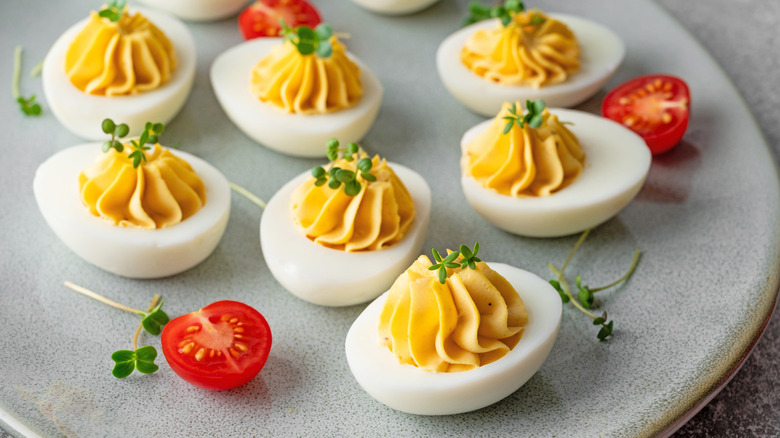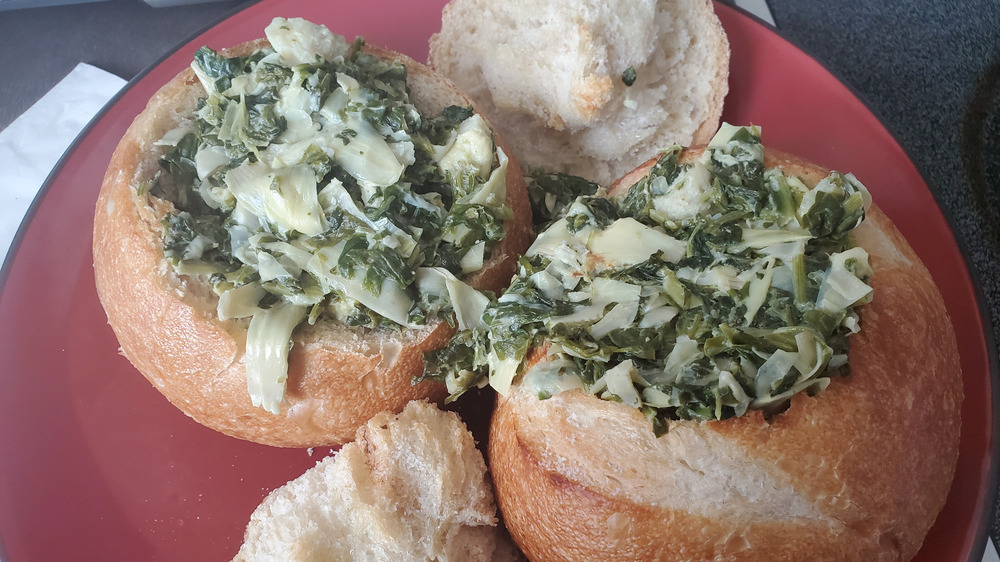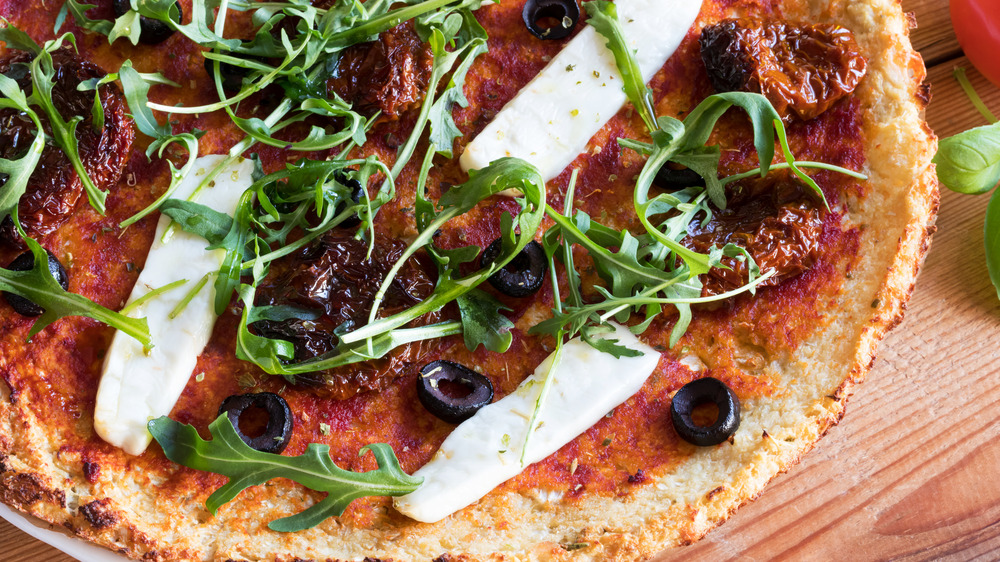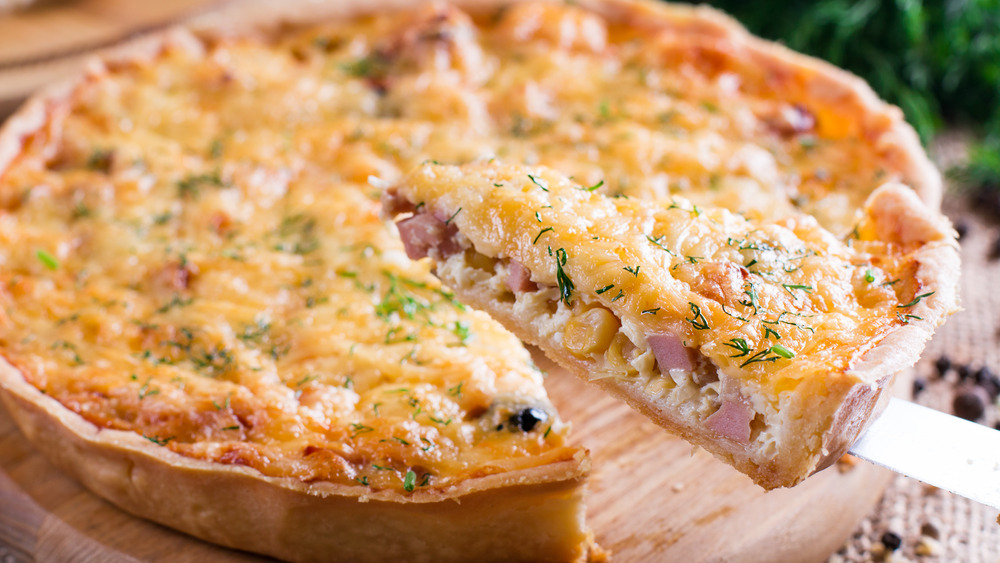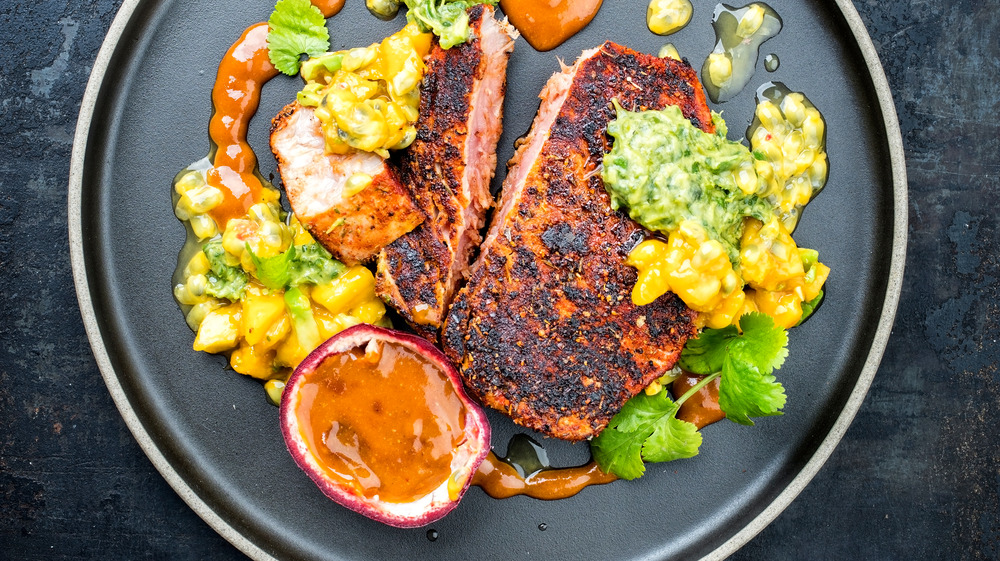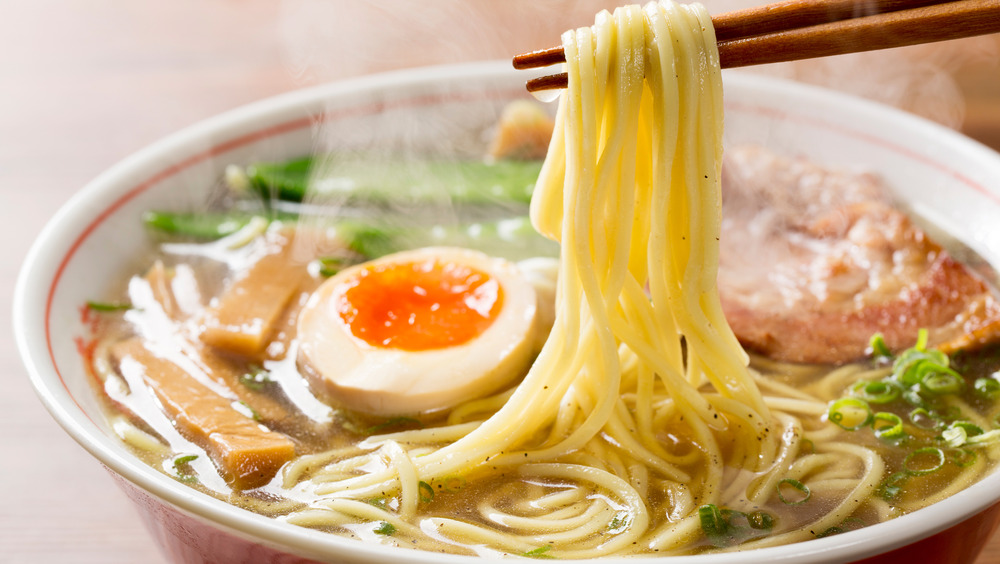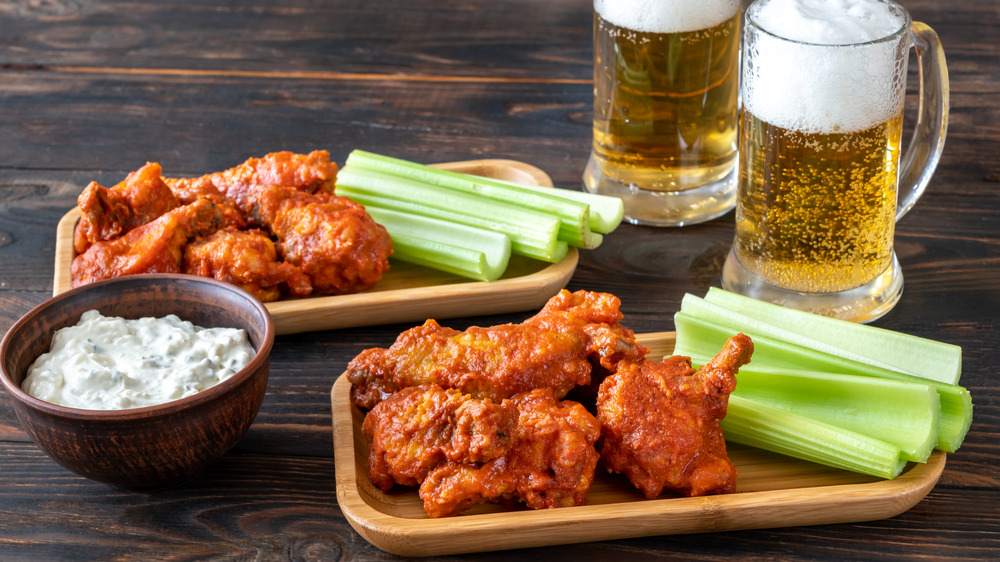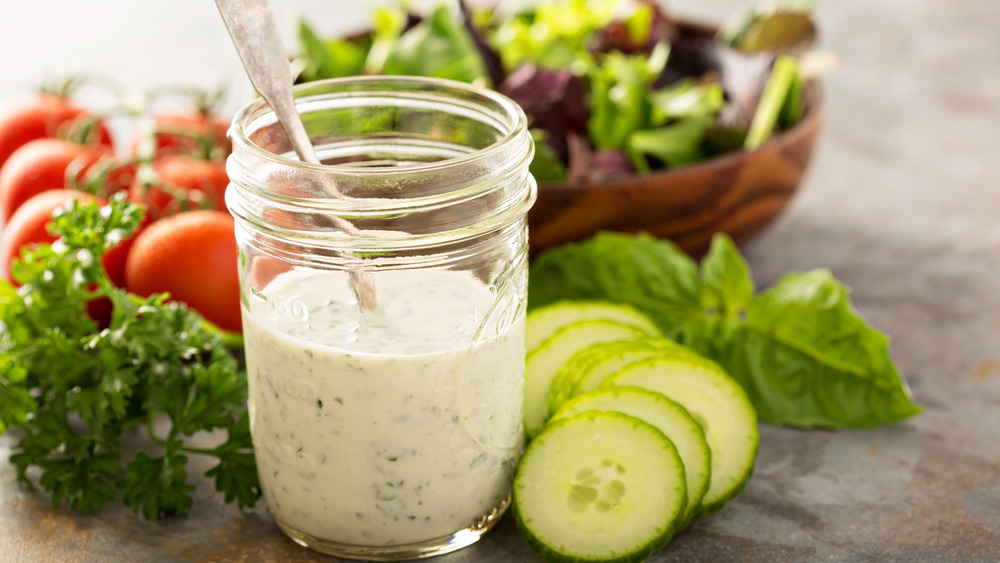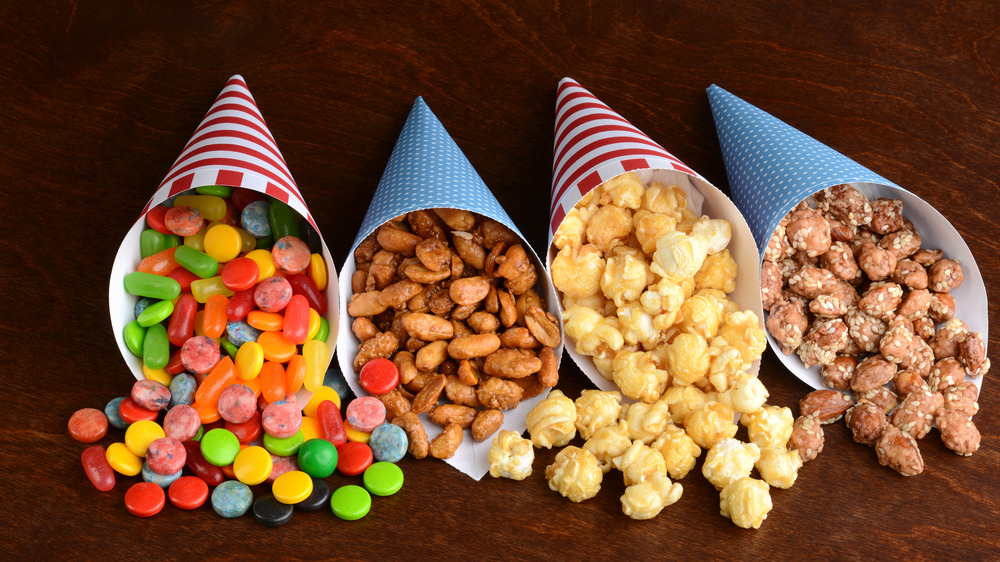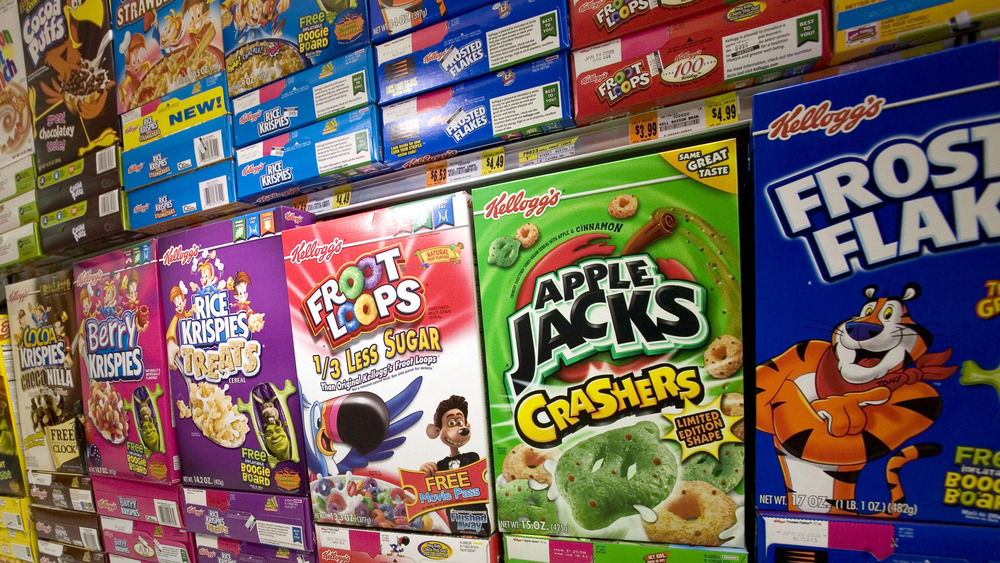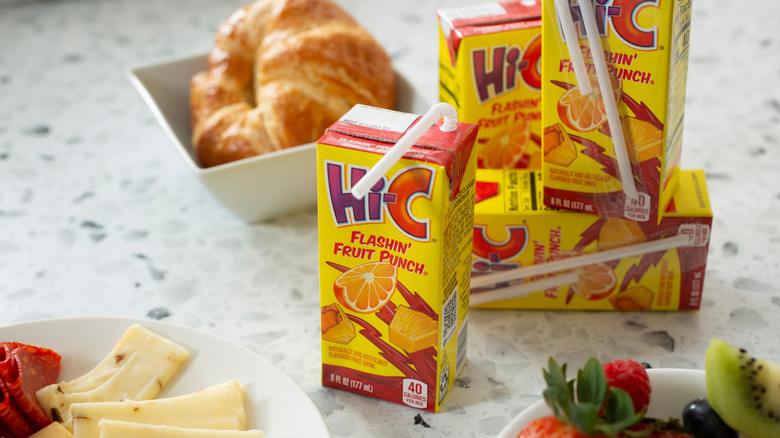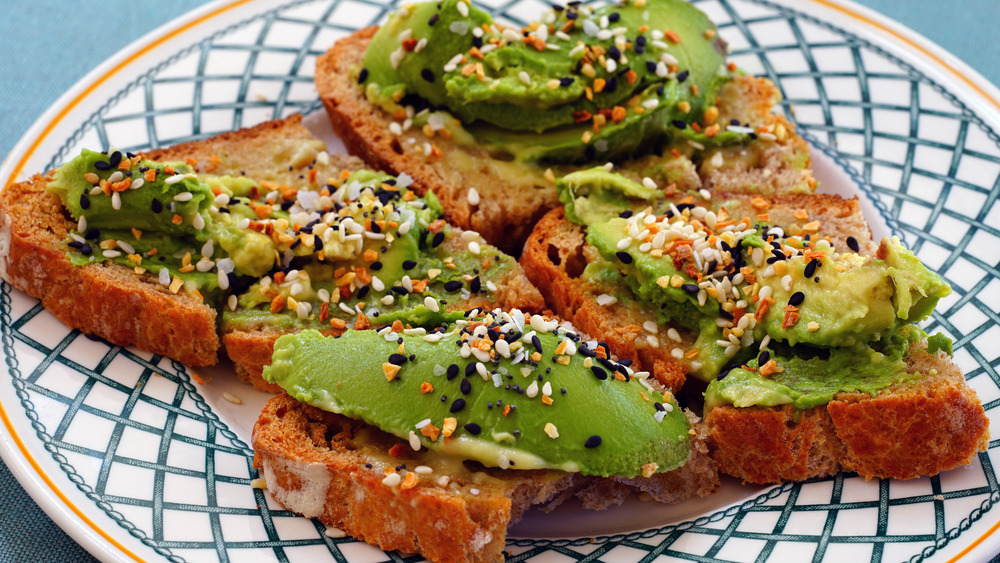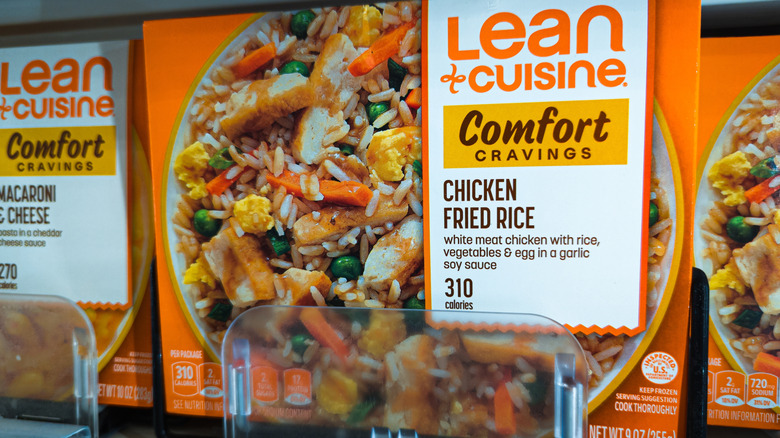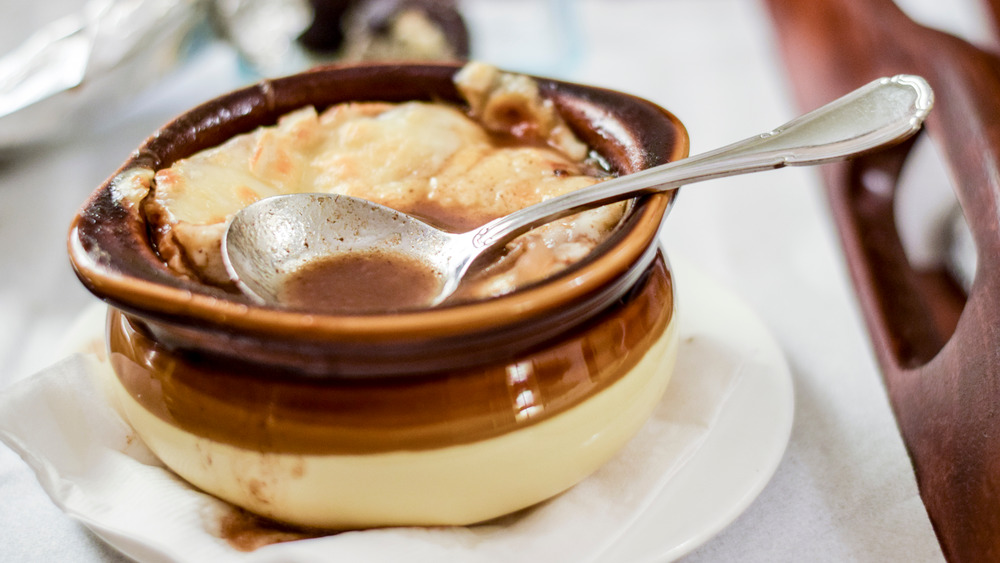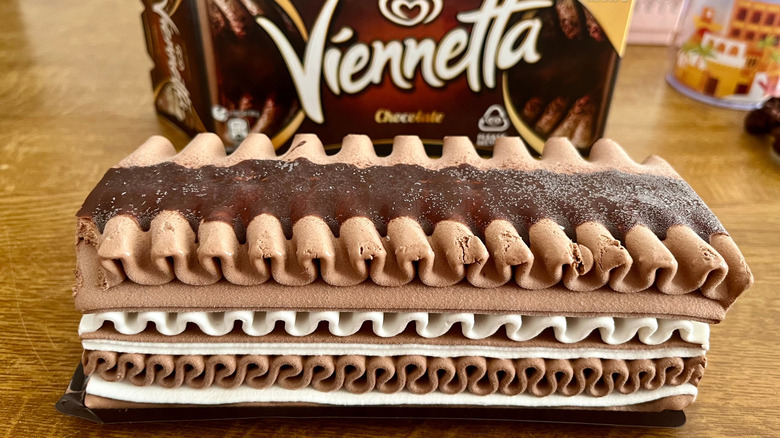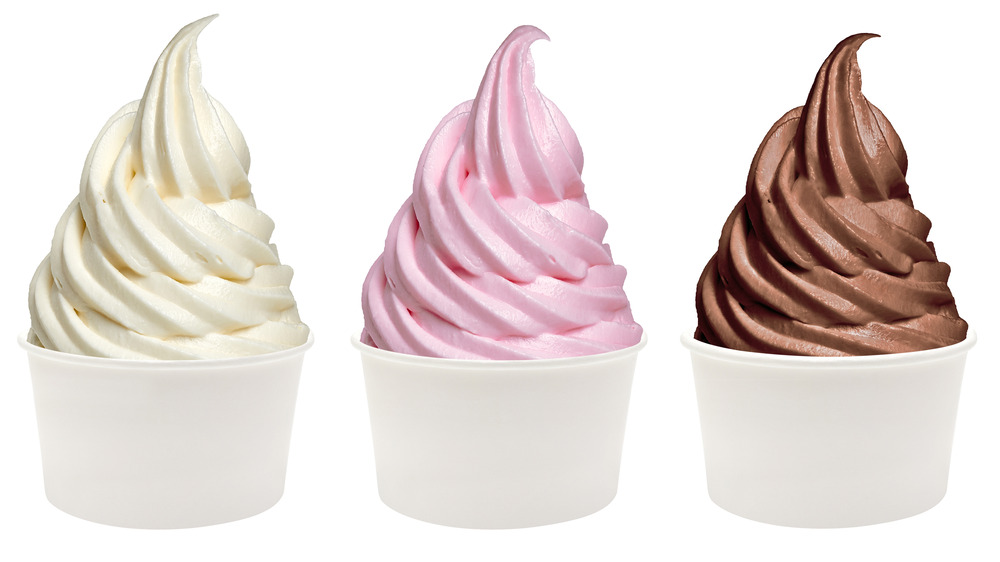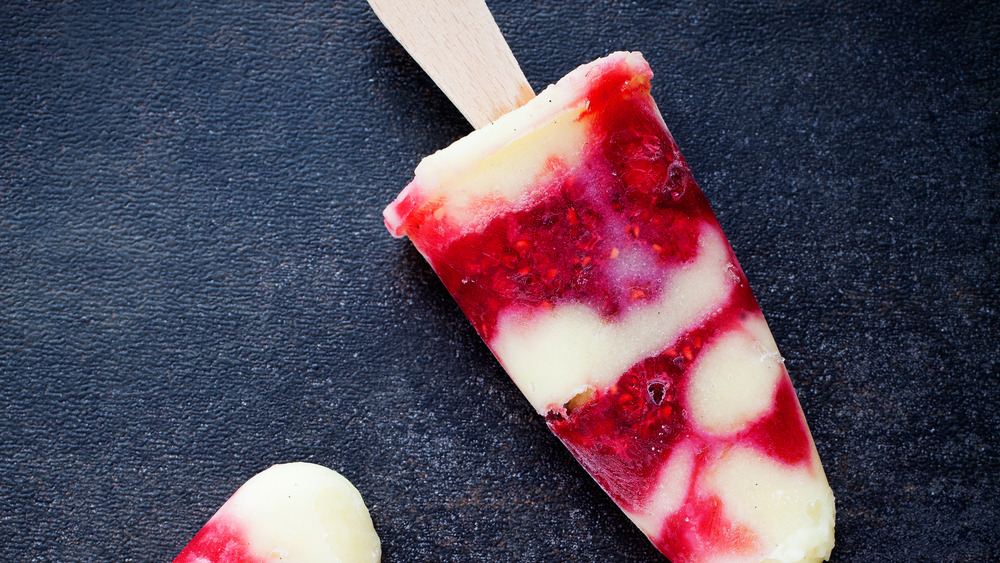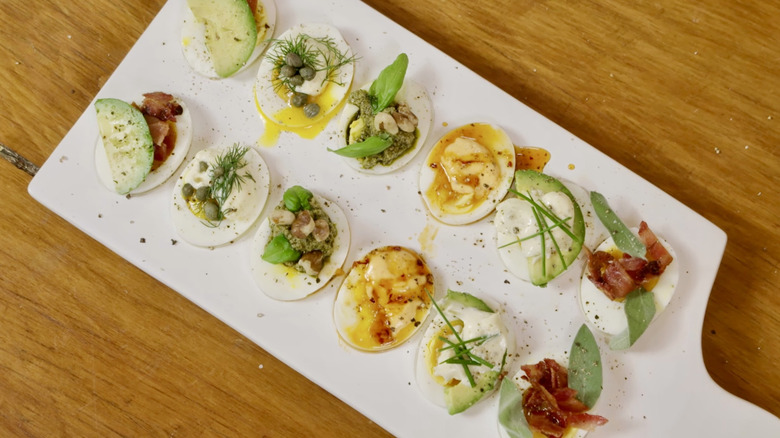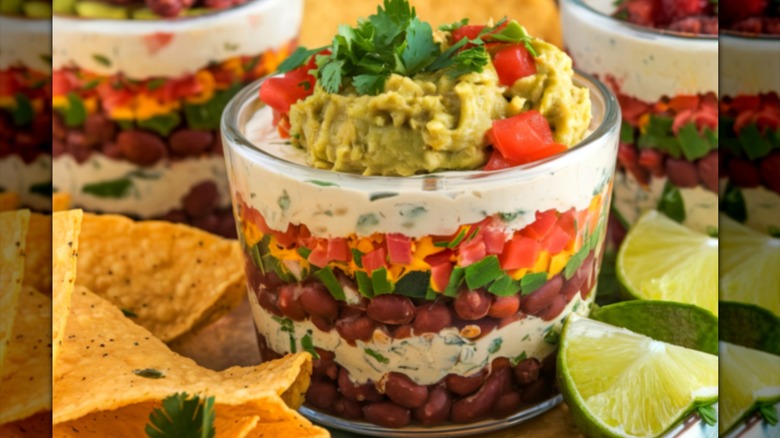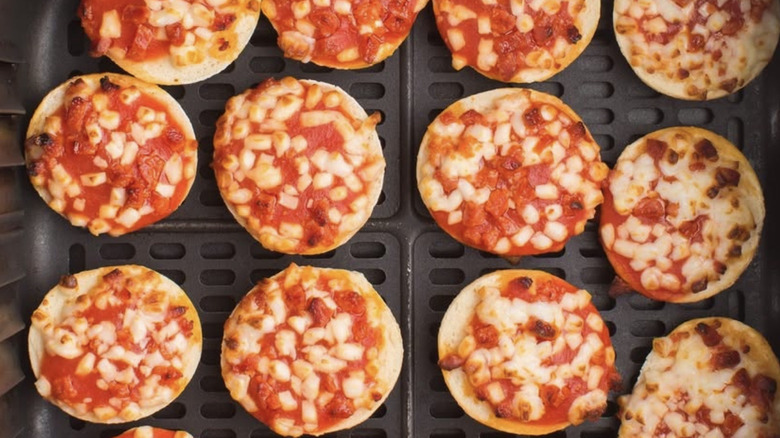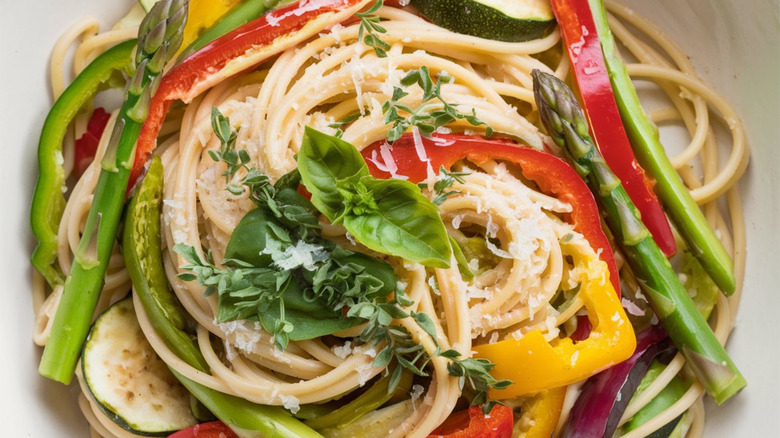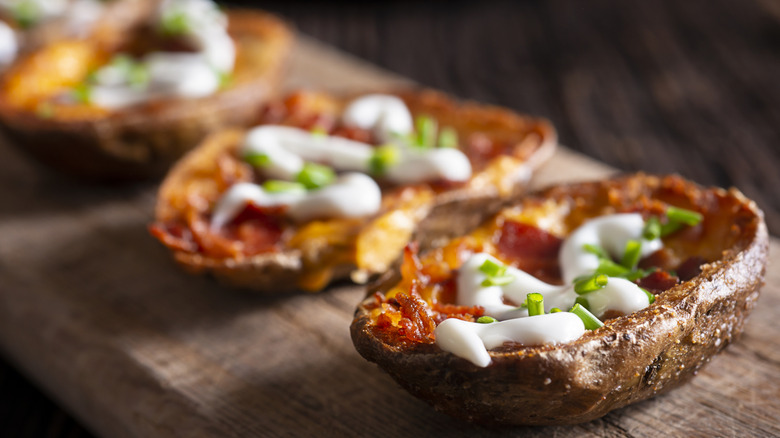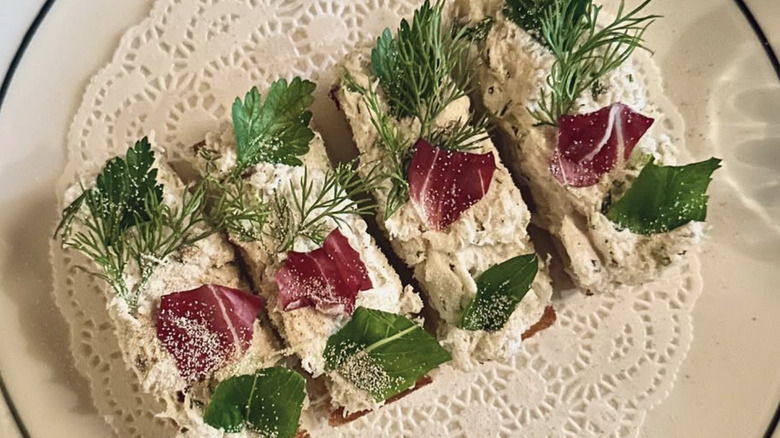Foods From The 1980s That Are Weirdly Making A Comeback
We may receive a commission on purchases made from links.
Fashions change dramatically throughout history. Think, for example, of how the war and pandemic-ravaged nineteen-teens gave way to the Roaring Twenties, with all of its frivolity and indulgence. And after the economically-challenged 1970s, the 1980s brought with it luxury and opulence — so that right before our very eyes, leisure suits gave way to power suits, long hair gave way to the slicked back Wall Street look, and alfalfa sprouts gave way to caviar and foie gras.
These days, you can sense something of a 1980s vibe in the air — or perhaps that's just the aroma of chicken wings, French onion soup, deviled eggs, and everything bagel seasoning making their comeback. In fact, all these 1980s foods have been making a comeback, some with a few delicious modern twists. So, is it really that weird to think that a return to shoulder pads, smooth jazz, and high-concept cinema might not be too far behind?
Bread Bowls: An '80s trend from the Middle Ages that's back again
When bread bowls started turning up as dinnerware and partyware in the 1980s, they weren't exactly new. They have been around since at least as far back as the Middle Ages, when repurposing a stale loaf of bread by hollowing it out and filling it up with hot stew, soup, or porridge became a way to cope amid famine conditions. Accordingly, the advent of bread bowls in the 1980s represented a "renaissance" of sorts — albeit an ironic one given that bread bowls made their 1980s-return as a way of giving soup merchants an excuse to charge more for their wares.
Today, bread bowls appear to be riding the wave of a comeback once again. And again, the comeback may represent the very antithesis of the purpose that bread bowls were originally meant to serve. You see, this comeback seems to have been engineered in part by bakery-café fast casual restaurant giant, Panera Bread. Following testing in 2018, the chain launched a new double sourdough bread bowl nationwide in 2019. And in the 2020s, the bread bowl trend has taken off once again on TikTok, where they're filled with everything from butter candles to creamy burrata and melted brie.
Sun-dried tomatoes: Back from the '80s, thanks to umami
During the 1980s, sun-dried tomatoes were everywhere in American cuisine. What made sun-dried tomatoes so popular, according to David Kamp, author of "The United States of Arugula," is that they were "versatile and simple" and not "too outlandish" (via Taste). "You could toss them in anything," Kamp elaborated. In fact, people did, tossing them into pastas and salads and onto pizzas, filling them with goat cheese, and even mincing and kneading them into bread dough and baking them up as sun-dried tomato bagels and dinner rolls.
By the mid-1990s, however, it appeared that sun-dried tomatoes' day in the sun was drawing to a close. When food critic Ruth Reichl accused the savory dried fruit of being monotonous, that seemed to be the last straw. Or was it? Apparently rumors of the demise of sun-dried tomatoes have been greatly exaggerated, because it appears that they are back – and it may be that we have the umami trend to thank for that. It also helps that they're a key ingredient in viral dishes like Marry Me Chicken.
Quiche: It's too versatile to be stuck in the 1980s
Quiche, which became popular in 1970s, was still enjoying its heyday in the early 1980s, when "it was served in countless restaurants on stoneware plates with melon wedges, grapes and some kind of green shrub." That's what the The New York Times wrote in 1987, in an apparent attempt to help stage a comeback for the dairy-rich meal-in-a-pastry. That comeback had partly become necessary thanks to the publication of Bruce Fierstein's "Real Men Don't Eat Quiche." Published in 1982, the bestseller poked fun at the dish.
Now, however, homemade quiche is making a comeback, and it's high time too because the retro dish is endlessly versatile, and can be eaten at any time of day. In 2020, The Dallas Morning News observed that quiche was "emerging" once again because "quiche is all things to all meals, the answer to what is for breakfast, lunch, brunch, or dinner. Add fruit for breakfast or brunch, or salad for lunch or dinner, and meals are complete." Quiche is just as popular today, from veggie-packed versions to classic quiche Lorraine.
Blackened foods: A 1980s trend that's re-emerged in a big way
The late great chef, Paul Prudhomme has been credited with introducing the world to blackened redfish. The Cajun trend became so hot in the 1980s that when Prudhomme opened a pop-up version of his legendary New Orleans restaurant, K Paul's, on New York City's Upper West Side in 1985, it drew a crowd of 250 people — even after the New York City health department shut the place down temporarily over hygiene concerns (via The New York Times). In the years that followed, redfish became so popular that it became overfished — to the point where it was no longer legal to fish for in most of the country.
But who needs redfish, when you can enhance just about any protein by coating it with butter and blackening spices and allowing it to char — especially when those spices are now readily available, pre-mixed, at virtually any supermarket? It's no surprise that blackened food such as marinated blackened chicken is making a comeback, as the technique adds such a tasty smoky depth to so many dishes.
Ramen noodles: An '80s trend that's more popular than ever
Nissin initiated the American ramen trend in 1970, when its Top Ramen began to appear on store shelves. Ramen rose to trendy heights in the 1980s because it was "wickedly cheap" and "edible raw," according to the Village Voice, which also noted that ramen was just right for the Cold War, which was still ongoing in the '80s, because "in a nuclear winter, it would be the cockroaches and the ramen that survived."
As far as college kids go, ramen noodles never really fell from favor. Instant ramen remains their go-to meal and late-night snack it has always been. Americans are the biggest consumers of instant ramen outside of Asia. However, in recent years, ramen has also taken on a more sophisticated, worldly vibe that has nothing to do with instant noodles, Styrofoam cups, or college kids, for that matter. And that is its own kind of comeback.
Now, you can find restaurants dedicated to ramen in major cities everywhere, with many offering gourmet twists on the dish. And yes, in case you were wondering, you are duty-bound to slurp your ramen loudly.
Buffalo chicken wings: Popular since the 1980s but soaring in the 2020s
Buffalo chicken wings rose to prominence in the 1980s, when health-conscious consumers started favoring boneless and skinless breast meat. This left chicken suppliers with a wing surplus. Hoping to rid themselves of that surplus, suppliers took to selling wings on the cheap. Restaurants and bars saw this as an opportunity to purchase inexpensive protein, spice it, fry it, and sell it for cheap — even with a reasonable markup.
As an extra-added bonus, spicy chicken wings tend to make people thirsty, which translates loosely into "more beer gets sold." On top of that, all of this was happening as sports bars started popping up across America. Chicken wings were already well-entrenched in American culture, but buffalo wings are now one of the most popular game day snacks once again.
In part, the surge in popularity may be due to the fact that chicken wings are one of the easiest foods to order and enjoy via takeout. But also because it's easy to make chicken wings in an air fryer for a more modern version.
Ranch dressing: A 1980s trend that's become an all-American classic
Steve Henson was a plumber from Nebraska working on a construction crew in Alaska when he came up with a mayonnaise-and-buttermilk-based salad dressing that made use of dried herbs and spices for seasoning. In 1954, when Henson and his wife moved to California and opened a guest ranch, the Hidden Valley, they served the dressing, which became so popular that guests started requesting souvenir jars. In 1983, Hidden Valley Ranch Salad Dressing was introduced in supermarkets, and an obsession spread across America — peaking in 1986 with the introduction of Cool Ranch Doritos.
For a good, long time after that, ranch dressing remained a part of Americana, but it was widely reviled by foodies who maintained that it had become dated. However, it was due a comeback.
At first, that comeback might have been characterized as mildly transgressive, with people buying into ranch dressing primarily because it represented a nostalgic "guilty pleasure." Before too long, however, ranch dressing and ranch seasoning started appearing in places that would never have tolerated it in the past — in upscale kitchens, drizzled on pizza, for marinating lamb, and as a dipping sauce for chicken wings.
Flavored popcorn: Started in the 1980s and getting even wilder today
You know those tins of flavored popcorn that people send as gifts around the holidays? Well, you can thank the 1980s for that. "A scant two years ago," the The New York Times wrote in 1983, "there was plain popcorn and buttered popcorn and caramel popcorn, and a few slightly more exotic flavors such as cinnamon for those who would dare," but by the early 1980s there was "pizza-flavored popcorn, watermelon-flavored popcorn, and taco-flavored popcorn, and the stores that sell them are called gourmet shops in the industry."
The New York Times also pointed out at the time that around 70% of the country's popcorn was "eaten at home, generating about $200 million in sales during 1982," with "popcorn confections and other specialty items accounting for another $100 million." Again, that was in 1983, but looking back, it could seem as if the publication was penning a future-letter.
The latest varieties of flavored popcorn are wilder than ever, including such flavors as fried chicken, Marmite, pumpkin spice, lemon sherbet, caffeine-infused, gin and tonic, dark chocolate pretzel, cookies 'n cream, and bacon and cheddar. In fact, there are all sorts of things you can add to your popcorn, from curry to matcha.
Sugary cereal: An 80s trend that's returning despite health concerns
Sugary breakfast cereals have been around for a while, but really became popular in the 1950s. By the 1980s, co-branding cereal began, with sugar cereals partnering with kiddie entertainment, thereby locking down the interest of American children.
By the 1990s, however, consumers were becoming increasingly health-conscious, and sugar cereals came to shoulder at least some of the blame for the increase in obesity among American children. Defensively, some sugar cereals began dropping the word "sugar" from their names.
In recent years, though, it appears that cereal manufacturers have once again been "doubling down on their sugary ways," according to The Wall Street Journal. The reason? Dwindling sales. As much as American consumers don't "want" sugary breakfast cereal, they also don't seem to have any interest in buying breakfast cereal that doesn't come pre-sweetened. Accordingly, some cereal manufacturers began adding more sugar. A study published in the journal JAMA Network Open in 2025 found sugar content in children's cereals increased by over 10% between 2010 and 2023.
Hi-C: An '80s juice that's poised to be big again
Given the resurgence in popularity of sugar-laden cereals, it shouldn't be all that surprising to learn that some sugar-sweetened fruit drinks have been coming back into style. Did you notice we didn't say "juice"? That's because the beloved fruit drinks that had their heyday in the 1980s tended to contain very little actual juice. Hi-C, for one, contained a mere 10% juice — and this remained the case in the 2010s. What these fruit drinks did contain was a lot of sugar, often in the form of high fructose corn syrup.
Hi-C, which had been around since 1946, enjoyed a huge surge of popularity in the 1980s thanks, in part, to the introduction of their Ecto Cooler juice boxes. Hi-C became a mainstay at McDonald's, with the Orange Lava Burst flavor becoming a cult favorite. So then why did McDonald's discontinue Hi-C in 2017?
Strangely enough, the decision had less to do with sugar and more to do with licensing obligations, according to Today, which explained in 2017 that McDonald's had recently entered into a partnership with Coca-Cola, makers of Sprite TropicBerry. "Apparently, Hi-C would have stolen the new drink's thunder." But in 2021, fans of Hi-C Orange Lava Burst could breathe a sigh of relief when McDonald's announced it was bringing the popular drink back. It's a still a popular addition to the menu.
Everything bagel seasoning: It's too tasty to leave in the 1980s
Made from poppy seeds, sesame seeds, dried minced garlic and onion, and sea salt, everything bagel seasoning has transformed bagels. Although it will probably never be known who exactly was the first person to throw these five ingredients together on top of a bagel, there are a few contenders.
What is known for certain is that by the 1980s, those five ingredients together were huge — at least as bagel seasoning. In fact, for quite a long time after that, those five ingredients came together for one purpose and one purpose only: to make a bagel taste like, well, everything.
Fast forwarding to now, however, it turns out that there's a whole new use for everything bagel seasoning. And that is as a seasoning – not just for bagels but for everything else as well. Trader Joe's sells a version under the name, Everything But The Bagel Seasoning. And who among us isn't wondering why we never of thought of it before?
'80s-style wine coolers: Back at the party in the 2020s
"Remember the wine cooler?" wrote Forbes in 2019. "It's back." And it's true, helped by iconic wine-cooler maker, Bartles & Jaymes, coming out with a pre-packaged canned cocktail that was both fizzy and made with wine — and, of course, canned cocktails in general have become ever-more popular in recent years. However, what is in those cans along with the fizzy wine is not what people who came of wine-drinking age during the wine-cooler-80s think of as "wine coolers."
The wine coolers of the 1980s were made from wine, carbonated water, and sugar, which made them as close as you could get to a commercially bottled wine-spritzer (wine diluted with soda). Not that anyone really needed a pre-bottled wine-spritzer when all you need to make your own wine spritzer at home is a glass of wine and a spritz. But 1980s wine coolers had their fans — such that wine coolers became big business, with Gallo, Seagrams, and Bartles & Jaymes as a few of the most popular players.
But then Congress had the bright idea of levying a massive excise tax on wine in the early '90s, thus making "wine blending bad business," according to Wine Folly. In response, cooler-manufacturers started replacing wine with cheap malt liquor. That's how Zima came to exist. On the plus side, taking wine out of the equation enabled beverage manufacturers to get super-creative with their flavors. On the negative side, is a wine cooler that waters down its wine with malt liquor really a wine cooler?
Lean Cuisine: An 80s health food trend that's adapted
Lean Cuisine's pre-prepared and calorie-conscious frozen meals debuted in the U.S. in 1981. Since then, the frozen food brand has been available in supermarkets across the country. However, it lost some considerable footing over the years, according to The Atlantic, which reported in 2014 that America's then-60-year-long love affair with frozen prepared meals was going through a bit of a rough patch. In fact, there was talk at the time of Nestlé unloading the brand altogether. Good thing they hung in there, because frozen foods have been enjoying a huge comeback since then.
In 2020, seeing a great opportunity, Nestlé grabbed it, relaunching more than half its existing offerings and introducing brand extension, Life Cuisine, "boasting gluten-free and high-protein attributes" (via Frozen Foods Biz). These days, Lean Cuisine meals also come in a huge variety of options, including "protein kick" versions.
French onion soup: A 1980s restaurant staple that might be back to stay
Americans started taking a keen interest in French cuisine starting in the 1970s. Some of the fancier French restaurants were serving nouvelle cuisine, with all its detailed precision, and on the more casual side of things were restaurants specializing in crepes and fondue. But by the mid-1980s, all these restaurants tended to have one item in common: French onion soup.
So ubiquitous was onion soup in those days that it came to be synonymous with steakhouses as well as French restaurants. Although French cuisine in America, with its heavy sauces and hefty price tag, had to make room for the introduction and rise of other international cuisines such as Japanese, Thai, pan-Asian, Northern Italian, and Indian, it appears that hearty homemade French onion soup is on the rise once again.
In a classic case of "you never realize what you want until its gone," it took Panera Bread's removing of French onion soup from its menu in 2019 for its diehard fans to self-actualize as such. In response, Panera put French onion soup right back on the menu. These days, homemade versions of the classic soup are still proving popular on TikTok, and you can add a French onion spin to everything from dips to potatoes.
Vienetta ice cream: An '80s treat that's come back again
Viennetta, a beloved mashup of ice-cream cake and ice-box cake, with wavy alternating layers of vanilla ice cream and chocolate candy, had its debut in the U.K. in 1982 and hit the U.S. soon after. Although it has remained a beloved dessert in the U.K., it was discontinued in the U.S. in the 1990s. But it was to return. "Fans have clamored for Viennetta's return for almost 30 years," a press release from Unilever, the parent company of ice cream brand Good Humor, said in January 2021. "In 2021, Good Humor grants their wish."
Although it's unclear why Viennetta ever disappeared from American supermarkets frozen food aisles in the first place, it's easy to infer why the company was eager to bring it back. And sweet frozen treats are a trend that keeps growing: 97% of Americans said they "liked" or "loved" ice cream in 2024, according to the International Dairy Foods Association.
Frozen yogurt: Trendy in the 1980s but a go-to in the 2020s
Although yogurt has been in the U.S. since the early 1900s, frozen yogurt wasn't commercially available until the 1970s. That first frozen yogurt was designed to be scooped the way you scoop hard ice cream — but it didn't really catch on. Then, in the 1980s, soft-serve frozen yogurt was invented. Marketed as a soft serve dessert that tasted similar to ice cream, it took off in popularity as consumers began to pay attention to healthy eating and "healthy ingredients," according to the Frozen Yogurt Mix blog — which also noted that by 1990, frozen yogurt represented 10% of frozen dessert sales.
And therein lies the rub. Frozen yogurt was, ultimately, just another frozen dessert. As it turned out, no matter how "healthy" frozen yogurt might be, it's also pretty high in sugar, which makes frozen yogurt not necessarily a better choice than ice cream.
But guess what eventually has made a comeback? Frozen yogurt — only now it's not meant to taste like ice cream so much as like tangy yogurt. During its resurgence in recent years, the marketing didn't necessarily promise low calories, low fat, or low anything. And it's easy to make your own with just full-fat yogurt and sugar.
Pudding pops: Fans might bring back this bit of 1980s nostalgia
During the 1980s, lots of freezers contained Jell-O Pudding Pops as a sweet treat. For totally "selfish" reasons (Jell-O wasn't making enough of a profit off of them), Jell-O Pudding Pops were unceremoniously dropped from the frozen food aisle dessert lineup in the 1990s. Fans took it hard — there were petitions back then, just not on the internet.
Caving slightly in 2004, Jell-O licensed the Pudding Pops name to Popsicle for a reboot. Now, you might think that Popsicle, being a brand that specializes in frozen desserts, would have done Pudding Pops proud. However, this was not how things played out, according to Culinary Lore. Instead, "the texture was different, and they were made in a Popsicle shape using existing popsicle molds, instead of in the traditional Pudding Pop shape." Thanks to unimpressive sales, Popsicle stopped making its version of Pudding Pops around 2010.
To this day, the world has still yet to meet an adequate replacement for the goodness that was real Jell-O Pudding Pops — when they were made by Jell-O. And so we can't say that Jell-O Pudding Pops are back, per se. But that's not to say that people aren't trying, with lots of fans on TikTok coming up with their own versions.
Deviled eggs: Grandma's hors d'oeuvres goes viral
No picnic in the 1980s was complete without deviled eggs served on a platter (preferably with egg-shaped indents). Whether dusted with paprika, sprinkled with chives or a little bit of both, there was always something charming about grandma's classic deviled eggs recipe, even though nothing about it was modern. Deviled eggs have made a comeback, and their revival comes with an amped-up list of eclectic ingredients. In true 21st century fashion, deviled eggs 2.0 are an internet famous hors d'oeuvres with a huge social media following.
Deviled eggs went viral in 2024, particularly, deviled egg flights. Grandma wouldn't dream of making deviled eggs without a piping bag, but deviled egg flights that make the rounds on TikTok and elsewhere riff off the "lazy devil eggs" that trended a few years earlier. This deconstructed approach doesn't require hard-boiled egg yolks to be separated from their whites. Instead, a slather of umami-rich kewpie mayonnaise over each half of yolk serves as a base for a host of inventive ingredients.
What are deviled eggs of the 2020s topped with? Anything you like. Capers, caviar, crispy fried onions, sliced lox, or avocado — if you can dream it, you can achieve it. Unlike the precise piping method of the 80s, new-school deviled eggs (which can be hard or soft-boiled) are brimming with toppings and often drizzled with condiments or sauce. To make your deviled egg flight Instagram-ready, opt for fresh, colorful toppings.
Seven-layer dip is an '80s favorite with a 21st century twist
The market for vegetarian-friendly foods has expanded over the last several years, and this multi-tiered, colorful dip is right in step with what people want to eat now. Back in the 1980s, seven-layer dip was having a moment, especially on the potluck party circuit. The dip's popularity was born from America's infatuation with Tex-Mex cuisine — something that began ramping up in the late '70s. Seven-layer dip's demand fell off a bit over the years, but the no-bake sensation is back and festive as ever.
A recipe for seven-layer dip featured in a 1981 issue of Family Circle is largely credited for broadening its popularity (it was published as "Tex-Mex Dip"), but Family Circle actually credits the printed recipe to the Fort Worth Star-Telegram. That specific version calls for pre-made bean dip for the first layer, as well as a combo of mayonnaise, sour cream, and taco seasoning for layer three. Updated seven-layer dip recipes opt for canned refried beans and sour cream without the mayo. Those aren't the only ways seven-layer dip has evolved since making a comeback.
Treating the dip's avocado layer like genuine guacamole is prioritized more than the taco-seasoned avocado mixture the Family Circle recipe describes. Lime juice, cilantro, and anything else you might include in guacamole can and should be incorporated into that classic second layer. Black beans, fresh corn, and fruit salsas are all welcome additions to updated takes on seven-layer dip.
Bagel Bites were a classic after-school snack of the 1980s and they're back
Back in the day, pizza-inspired Bagel Bites were the after-school snack of champions. For many kids of the 1980s, walking through the door, firing up the oven, and eating a plateful of Bagel Bites while watching cartoons (or maybe attempting some homework) was a pleasant way to spend a weekday afternoon. After spending some years on the back burner, Bagel Bites are making a comeback in the 2020s, and their return tastes of cheesy tomato paste nostalgia.
Bagel Bites may have burned the roofs of many mouths several times over, but they were also comforting to those who were coming of age in the '80s. Arranging them on a cookie sheet and placing them into a preheated oven gave latch key kids confidence to use the oven while mom was still at work. For adults, they were a lazy dinner or a choice midnight snack.
In 2021, Bagel Bites hit the news big time in Canada when they departed from national shelves. After that, over 80% of Canadian Bagel Bites fans stopped shopping for frozen heat-and-eat snacks entirely. This exodus, and a flurry of vocal discontent from consumers led the bigwigs behind Bagel Bites to amend their ways. The freezer snack returned to Canada in the spring of 2024, reminding all of us that you don't know what you've got till it's gone.
Pasta primavera freshens up for the 2020s
Pasta primavera's heyday was the 1980s. That's when it was served in upscale metropolitan restaurants like Le Cirque in Manhattan, where the dish originated a decade before. The pasta primavera of the '70s and '80s bathed spaghetti and assorted vegetables in a rich, cheesy sauce — one aspect of the dish that feels too clunky now. Yet the idea of using peak-season fresh veggies to brighten up a pasta dish is exactly how the chefs of today like to cook. Emphasizing pasta primavera's seasonality has breathed new life into the entrée, which may have otherwise been left for good in '80s-era fine dining kitchens.
The heavy sauce of the original pasta primavera isn't the only element that has gotten reworked. In predictable haute cuisine fashion, Le Cirque's pasta primavera's preparation and ingredients list were fussy, or extra as the kids today might say. The original recipe is a 10-step ordeal that involves trimming and cooking and blanching a lot of different vegetables, mincing herbs, toasting pine nuts, then adding heavy cream ... and butter ... and chicken broth. Pasta primavera's comeback was begging for edits.
Roasting the seasonal veggies is a welcome revision. Rather than juggling multiple cooking techniques (boiling green beans and sauteing mushrooms are just two of the directives of the Le Cirque version), roasting a mix of vegetables of the cook's choosing adds an extra depth of flavor. No cheese needed.
1980s-era potato skins get a modern makeover
T.G.I. Fridays took potato skins mainstream, and pub menus kept them from extinction, but apart from their reputation as a greasy bar bite or a winning game day appetizer, potato skins peaked in the '80s. T.G.I. Fridays (and a couple of other U.S. restaurants) claimed to have invented potato skins in the 1970s. By the mid 1980s, the appetizer was so popular, farmers had to grow more potatoes so restaurants wouldn't run out. Whether you liked your potato skins with cheddar and bacon or preferred them with sour cream and chives, over the years their novelty wore off. But that seems to be changing.
For a long time, potato skins have existed somewhere within the space between food fad and guilty pleasure. Thanks to a few tweaks to the traditional loaded potato skins recipe, this throwback app has entered an era of versatility and refinement. For plant-based potato skins (because potatoes are plants after all), black beans and vegan sour cream are great stand-ins for the usual bacon bits and dairy without sacrificing taste or texture. Unexpected condiments like kimchi mayo and spicy Korean-style gochujang sauce give the typical all-American potato skins a flavor-packed Asian flair.
Crab toast is an '80s canapé that people love again
For a while, dainty finger sandwiches and other highly manicured canapes were dismissed as old-fashioned and pretentious — and yeah, they kind of were. Crab toast was very much part of this passé food category, having spent much of the 20th century on a decorative tray. Now, these crustless creations are back, because one thing that should never go out of style is delicious food.
Crab toast was conceptualized well before the 1980s, but stayed relevant throughout the decade. It is similar to a finger sandwich (also referred to as a tea sandwich), in the sense that it is a petite offering of bread topped with a mayo-based salad. Crab toast's presence at the table often signified that a social gathering was underway. Ladies luncheons or garden parties were some of the occasions where old-school tea sandwiches and toast points fit the vibe perfectly.
Back in the '80s, some crab toast was made using canned crab meat, while other versions featured imitation crab sticks. Some older recipes also incorporated Kraft's Old English Cheese Spread. 21st-century recipes encourage the use of fresh lump crabmeat, fresh herbs, extra virgin olive oil, and lemon juice. Rounds of toast are also a modern inclusion that take crab toast into more of a crostini direction, while opting for trimmed-down planks of crispy sandwich bread or squares of cocktail rye are a playful wink to crab toast's retro roots.
